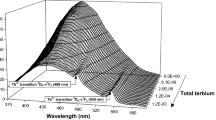Summary
Two fluorescence techniques to study metal-humic interactions are presented. In the first technique, Lanthanide Ion Probe Spectroscopy (LIPS), the humic samples are titrated by Eu3+ ions. The ratio of the intensities of two emission lines of Eu3+, R=I592/I616, is used to estimate the amount of bound and free species of the probe ions. The titration plot is presented as R versus the logarithm of total added Eu3+. In the second technique, fluorescence quenching of the humic material by Cu2+ is used to produce titration curves of intensity versus the logarithm of total added Cu2+. The two techniques are used in conjunction with a model that treats the various ligands in humic substances as continuous distributions of binding sites in which individual ligand concentrations are normally distributed with respect to the individual stability constants for metal binding. The model includes the effects of pH, ionic strength, and competing metal ions. The parameters of the model are estimated by fitting the spectral titration data to the calculated titration plot. Some simulation and experimental data are presented and discussed.
Similar content being viewed by others
References
Weber JH (1983) In: Christman RS, Gjessing ET (eds) Aquatic and terrestrial humic materials. Ann Arbor Science, Ann Arbor, MI
Perdue EM, Lytle CR (1983) Environ Sci Technol 17:654
Kim H (1970) J Chem Ed 47:120
Horrocks WDeW, Sudnick DR (1979) J Am Chem Soc 101:334
Carnall WT (1983) In: Sinha SP (ed) Systematics and the properties of the lanthanides. Reidel, Boston, pp 449–450
Dobbs JC, Susetyo W, Knight FE, Castles MA, Carreira LA, Azarraga LV (1989) Anal Chem 61:483
Ryan DK, Weber JH (1982) Environ Sci Technol 16:868
Dobbs JC, Susetyo W, Carreira LA, Azarraga LV (1989) Anal Chem 61:1519
Perdue EM (1988) Personal communication
Susetyo W, Dobbs JC, Carreira LA, Grimm DM, Azarraga LV (1990) Anal Chem 62 (in press)
Serkiz SM, Perdue EM (1989) Submitted to Water Res
Brown DS, Allison JD (1987) MINTEQA1, Equilibrium Metal Speciation Model, Users Manual EPA/600/3/87/012 USEPA, Athens, Georgia
Author information
Authors and Affiliations
Rights and permissions
About this article
Cite this article
Susetyo, W., Carreira, L.A., Azarraga, L.V. et al. Fluorescence techniques for metal-humic interactions. Fresenius J Anal Chem 339, 624–635 (1991). https://doi.org/10.1007/BF00325549
Received:
Issue Date:
DOI: https://doi.org/10.1007/BF00325549




